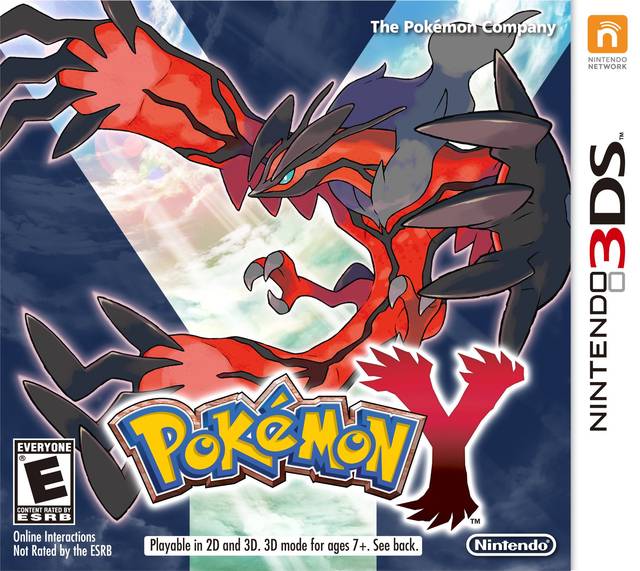
The Y Pokéromosone
Though the Game Freak-developed and Nintendo-published Pokémon franchise, known in Japan as Pocket Monsters, has existed since the Big N’s original monochrome Game Boy portable system, it wasn’t until series entries began appearing on the DS that I actually got into the games, and while I found the titles to have many positive aspects, I felt their actual gameplay were somewhat unrefined. Regardless, I continued to give future series entries a chance, though surprisingly, I completely missed out on the 3DS installments of the franchise, until I recently downloaded a ton of games to my system’s SD card due to the eShop closing in 2023, among them being Pokémon Y, coupled with sibling title X, which provides an experience largely on par with other entries.
When starting a new game, the player customizes their protagonist, who lives with a single mother and goes on a quest to become the greatest Pokémon champion in X and Y’s respective region of the world, whilst dealing with the sinister Team Flare. There is some decent backstory, although to say that the generation’s narrative is “formulaic” would be an understatement, along with the typical series goal of “catching ‘em all”. The translation is definitely more than legible, although it’s fairly bland, peppered with plentiful unnatural dialogue and some stylistic choices such as using “OK” instead “okay” when in just about any kind of writing the latter has more aesthetic pleasance.
Happily, the series’ signature gameplay largely compensates for whatever narrative shortcomings the X and Y generation has, mostly remaining unchanged from generations before it aside from the ability to grant temporary “mega evolutions” to specific ‘mons, not to mention the ability to toggle on/off experience sharing among monsters in the player’s active party of up to six of the franchise’s eponymous entities. The same positive and negative aspects return, in the former case the ability to exploit Pokémon strengths and weaknesses to triumph in battle, and in the latter instance that switching active monsters wastes the player’s turn. It’s a fun system overall, and a step above the gameplay of the DS entries of the series.
Another aspect with more or less the same positives and negatives is the X and Y entries’ control, with the returning ability to record progress anywhere, adjustable text speed, and eventual ability to use the Fly Hidden Move for rapid conveyance among visited cities. However, some of the same issues return such as the clunkiness of the game menus and confirmations when it comes to things such as overwriting the current abilities of a Pokémon’s move set with different skills, accounting in the end for above-average, but certainly not perfect, interaction with players.
The soundtrack remains a high point of the X and Y games, with plenty of upbeat, energetic tracks (particularly during combat) and pleasant themes for towns and anywhere in between. The sound effects are good as well, and the near-death alarm for Pokémon is less annoying in that it only dings a few times before stopping once a ‘mon reaches low health, although the digitized cries for different Pokémon still sound primitive at times.
The visuals look pleasant as well, with pretty colors, environments, unique designs for every Pokémon, good human character art, nice cel-shading, vivid illumination effects, savvy use of the 3DS’s three-dimensional capabilities especially in battle, and so forth, but there is some degree of pixilation in addition to jaggies and some slowdown most noticeable in combat.
Finally, playtime for the main storyline runs in the upper end of the twenty-four-to-forty-eight-hour range, with plentiful lasting appeal in the form of catching all Pokémon in addition to other postgame content, multiplayer battles via online capability, a starting choice of which element of ‘mon to use, and so forth, although absolute completion of the Pokédex would probably necessitate use of a guide.
Overall, Pokémon Y is another addition to the series that only takes it a few steps forward in terms of gameplay, which is nonetheless enjoyable, whilst having general great audiovisual presentation and plentiful lasting appeal. However, it bequeaths many flaws from its precursors such as the clunk interface, garden-variety narrative, average localization, and that achieving total completion necessitates the use of the internet, be it for referencing a guide or trading with other players. Regardless, long-term fans of the franchise will likely get the most out of it, and those new to the series might find it a little more accessible than its predecessors.
This review is based on a playthrough of a digital copy downloaded to the reviewer’s Nintendo 3DS and completed through the main storyline.
The Good:
+Good Pokémon gameplay.
+Excellent soundtrack.
+Nice visuals.
+Plenty lasting appeal.
The Bad:
-Menus and confirmations can be cumbersome.
-Typical Pokémon plot.
-Lackluster translation.
-Getting 100% completion can require a guide.
The Bottom Line:
Another run-of-the-mill, but still enjoyable, series entry.
Score Breakdown:
Platform: Nintendo 3DS
Game Mechanics: 8.0/10
Controls: 7.0/10
Story: 3.0/10
Localization: 5.0/10
Music/Sound: 9.5/10
Graphics: 8.0/10
Lasting Appeal: 8.5/10
Difficulty: Varies
Playing Time: 24-48 Hours
Overall: 7.0/10
No comments:
Post a Comment